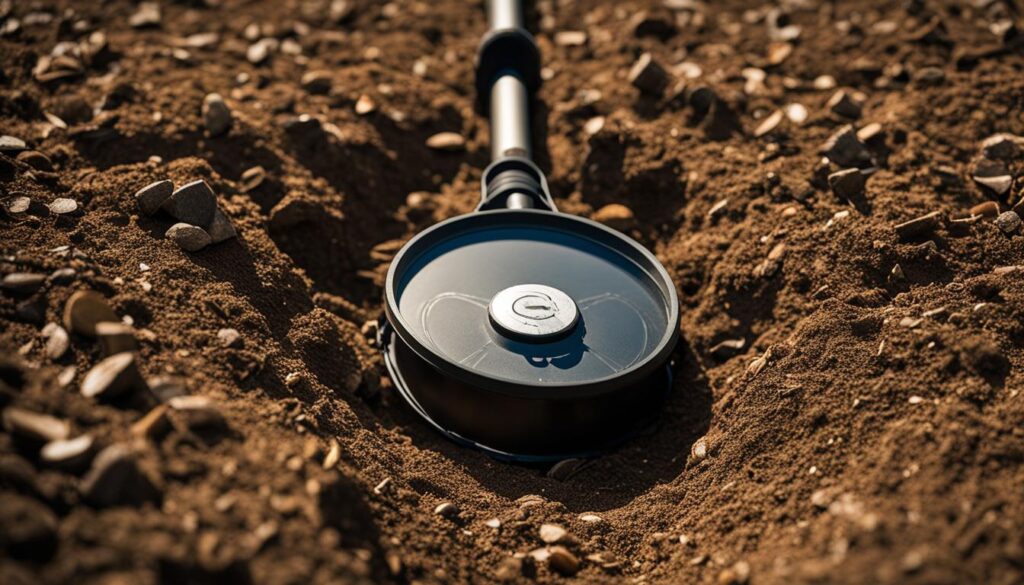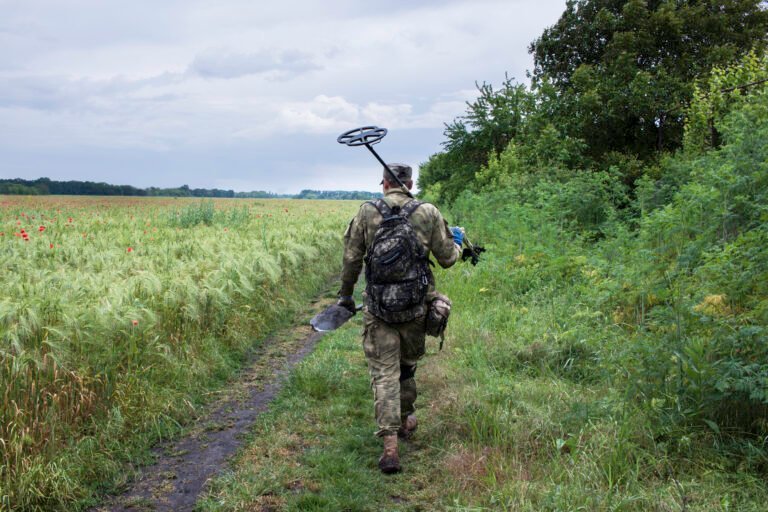Metal detector sensitivity and depth are crucial factors in successfully uncovering hidden treasures.
Achieving the right balance between these two aspects is essential for optimizing the performance of your metal detector.
In this guide, we will explore the importance of sensitivity and depth, how to set the sensitivity on your metal detector, tips for increasing depth detection, different types of metal detector frequencies, understanding ground balance, and factors that can affect sensitivity and depth.
Key Takeaways:
- Setting the sensitivity correctly is crucial for optimal performance and finding the right balance.
- Metal detector sensitivity determines how deep the device can detect a target object.
- Manually adjust the sensitivity or use the auto-sensitivity option to set the sensitivity on your metal detector.
- Increasing sensitivity, swinging closer to the ground, reducing discrimination, and experimenting with settings can enhance depth detection.
- Metal detectors use Very Low Frequency (VLF) and Pulse Induction (PI) frequencies, each with its advantages in specific detecting scenarios.
- Ground balance helps minimize the effects of ground minerals on depth detection.
- Factors such as metal type, object orientation, environmental conditions, and ground mineralization can affect sensitivity and depth.
Now that you understand the importance of sensitivity and depth, let’s explore how to set the sensitivity on your metal detector and dive into tips and tricks for increasing depth detection.
Understanding Metal Detector Sensitivity
When it comes to metal detectors, understanding sensitivity is crucial for successful treasure hunting. Metal detector sensitivity determines how deep the device can detect a target object. It is measured by the device’s ability to detect specific types and sizes of metal targets. The sensitivity levels are often indicated in terms of the diameter of the metal pieces.
The higher the sensitivity, the smaller the pieces of metal it can detect. This means that a metal detector with high sensitivity can pick up tiny objects such as small coins or jewelry buried deep underground.
To give you a better idea, here is a simplified visual representation of metal detector sensitivity levels:
| Sensitivity Level | Diameter of Detected Metal |
|---|---|
| Low | Larger objects |
| Medium | Medium-sized objects |
| High | Small objects |
| Ultra-High | Tiny objects |
Understanding metal detector sensitivity is essential for getting the most out of your device. By adjusting the sensitivity level, you can increase the chances of finding valuable items and make your metal detector super sensitive to small targets.
Now that you understand the basics of metal detector sensitivity, let’s explore how it works and how you can optimize it to enhance your treasure hunting adventures.
How to Set the Sensitivity on a Metal Detector
When using a metal detector, it is essential to set the sensitivity correctly to ensure optimal performance. There are two ways to adjust the sensitivity: manually or using the auto-sensitivity option.
To manually set the sensitivity, follow these steps:
- Start with the sensitivity set to the lowest level.
- Gradually increase the sensitivity or gain until you detect interference or false signals.
- Once interference is detected, turn down the sensitivity slightly to ensure more accurate signals.
It is important not to set the sensitivity too high, as it may result in unwanted responses and false signals. Finding the right balance is key to successful metal detecting.
If your metal detector has an auto-sensitivity option, you can let the device adjust the sensitivity automatically. This option is useful for beginners or if you are unsure about the ideal sensitivity settings for your specific metal detecting environment.
Experimenting with Sensitivity
Every metal detecting situation is unique, and the ideal sensitivity setting may vary. Experimenting with the sensitivity is crucial to finding the proper setting for your device.
“Setting the sensitivity on a metal detector is like finding the volume control on a radio. You want it loud enough to hear the music but not too loud that it becomes distorted.”
By gradually adjusting the sensitivity and checking for stable signals, you can determine the optimal setting for your metal detector. It is recommended to practice in different environments and with different targets to get a feel for how the sensitivity setting affects the device’s performance.
Remember, the goal is to find a stable signal that allows you to detect valuable targets while minimizing false signals caused by interference or ground noise.
| Benefits of Proper Sensitivity Settings: | Challenges of Incorrect Sensitivity Settings: |
|---|---|
|
|
By setting the sensitivity correctly on your metal detector, you can optimize its performance and increase your chances of finding valuable treasures. Remember to always refer to your metal detector’s user manual for specific instructions on adjusting sensitivity and gaining a better understanding of its features.
Metal Detecting Tips for Increasing Depth
If you’re looking to uncover hidden treasures at greater depths, here are some metal detecting tips to help you increase the depth capabilities of your metal detector:
- Turn up the sensitivity: Increasing the sensitivity setting on your metal detector can help detect targets at greater depths. However, it’s important to adjust the sensitivity under the right circumstances to avoid false signals. Experiment with different sensitivity levels to find the sweet spot for your detecting environment.
- Get closer to the ground: Swinging the detector’s coil closer to the ground can enhance the depth of detection. By keeping the coil low and parallel to the ground, you optimize its ability to pick up signals from deeper targets.
- Reduce discrimination: Lowering the discrimination setting on your metal detector can also help in detecting deep targets. Discrimination is the detector’s ability to ignore certain types of metal. By reducing discrimination, you increase the chances of finding deeper objects, even those made of less conductive metals.
- Know your detector: Familiarize yourself with the settings and features of your metal detector. Each detector is different, so understanding your specific model will give you an advantage in detecting deep targets. Take the time to read the user manual, watch instructional videos, and join online forums to learn from experienced detectorists.
- Vary swing speeds: Experiment with different swing speeds when using your metal detector. Slow, deliberate swings can often increase the depth of detection, allowing the detector to process signals effectively. However, don’t be afraid to try faster swings as well, as they can uncover targets that may have been missed with a slower pace.
- Use headphones: Investing in a pair of headphones for metal detecting can greatly enhance your depth detection capabilities. Headphones help block out ambient noise, allowing you to focus on the faint signals coming from deeper targets. This can significantly improve your ability to hear subtle variations in tone and increase your chances of finding valuable treasures.
By following these tips and tricks, you can maximize the depth capabilities of your metal detector and increase your chances of finding buried treasures.
Comparison of Metal Detecting Tips for Depth
| Tips | Benefits |
|---|---|
| Turn up the sensitivity | Helps detect targets at greater depths |
| Get closer to the ground | Enhances the depth of detection |
| Reduce discrimination | Increases chances of finding deep targets |
| Know your detector | Optimizes the detector’s performance |
| Vary swing speeds | Allows for more comprehensive coverage |
| Use headphones | Enhances depth detection capabilities |
Different Types of Metal Detector Frequencies
Metal detectors use two different types of frequencies: Very Low Frequency (VLF) and Pulse Induction (PI). Each frequency has its own unique characteristics and applications in metal detecting.
VLF Metal Detector
VLF metal detectors operate by transmitting and receiving electromagnetic waves at a low frequency. These detectors typically use two coils: a transmitter coil and a receiver coil. The transmitter coil emits an electromagnetic field into the ground, and when it encounters a metal object, it causes a change in the field. The receiver coil then detects this change and alerts the user through visual and audio cues.
VLF metal detectors are versatile and suitable for various types of metal detecting activities. They are commonly used for coin shooting, relic hunting, jewelry finding, and gold prospecting. VLF detectors offer adjustable sensitivity settings, discrimination features, and different operating modes to optimize target detection and filtering in different soil types.
Here is a comparison table highlighting the key features of VLF metal detectors:
| VLF Metal Detectors | Features |
|---|---|
| Transmitter and receiver coils | Emits and detects electromagnetic waves |
| Visual and audio cues | Indicates presence and type of metal targets |
| Adjustable sensitivity | Customize detection depth |
| Discrimination features | Filter unwanted targets |
| Multimode operation | Optimize performance in various soil types |
PI Metal Detector
PI metal detectors work on a different principle compared to VLF detectors. Instead of emitting continuous electromagnetic waves, PI detectors use bursts of electronic currents. These bursts generate a magnetic field that can penetrate deeper into the ground and detect metal objects at greater depths.
PI detectors excel in finding deeply buried objects and are commonly used for beach and underwater detecting, as well as in areas with highly mineralized soil. They are less affected by mineralization, making them suitable for challenging detecting environments.
While PI detectors offer impressive depth capabilities, they may be less proficient in target discrimination compared to VLF detectors. Here are the key features of PI metal detectors:
| PI Metal Detectors | Features |
|---|---|
| Use bursts of electronic currents | Generate bursts of magnetic field for detection |
| Deep searching capabilities | Detects metal objects at greater depths |
| Less affected by ground mineralization | Suitable for highly mineralized soil |
| Less target discrimination | May detect various metal targets without differentiation |
When choosing a metal detector, consider the type of metal detecting you plan to do and the specific conditions of your target area. VLF detectors are generally more versatile and offer better discrimination features, while PI detectors excel in deep searching and challenging detecting environments.
Remember, optimizing your metal detecting experience requires understanding the range of frequencies and their applications to make an informed decision that aligns with your detecting goals.
Understanding Ground Balance for Depth Detection
Ground balance plays a crucial role in optimizing the depth detection capabilities of metal detectors. The presence of ground minerals can introduce interference and false signals, hindering the ability to detect targets at greater depths. To combat this, metal detectors are equipped with a ground balance feature that allows users to minimize the effects of ground minerals and ensure accurate target identification.
Ground balance settings are designed to limit signals from ground minerals while maximizing sensitivity to metal targets. By fine-tuning the ground balance, users can effectively discriminate between mineralized soil and actual metal objects, improving the overall depth detection performance of their metal detectors.
There are three main types of ground balance settings:
- Manual Ground Balance: With manual ground balance, users have the freedom to adjust the ground balance setting based on the type of soil they are detecting in. By manually finding the optimal ground balance setting, users can customize their metal detector’s performance to suit different soil conditions.
- Automatic Ground Balance: Automatic ground balance takes the guesswork out of finding the optimal setting by automatically determining and adjusting the ground balance based on the current soil conditions. This feature is particularly useful for beginners or when detecting in areas with varying levels of ground mineralization.
- Tracking Ground Balance: Tracking ground balance is a dynamic setting that continuously adjusts the ground balance as you move and detect in different soil conditions. It ensures that the metal detector remains optimized for accurate depth detection regardless of changes in ground mineralization levels.
Proper ground balancing is essential for achieving accurate and deep target detection. By effectively managing the effects of ground minerals, users can minimize false signals and maximize the depth at which metal targets can be detected.

Disclosure: This Post Contains Affiliate Links; We earn a commission on purchases.
Ground balance settings are typically adjusted based on the specific metal detector model and the user’s geological conditions. Experimentation and practice are key to finding the optimal ground balance setting for your metal detector and detecting environment.
Remember, by understanding and utilizing ground balance effectively, you can unlock the full potential of your metal detector’s depth detection capabilities.
Factors Affecting Metal Detector Sensitivity and Depth
When it comes to metal detectors, several factors can influence their sensitivity and depth capabilities. Understanding these factors is essential for detectorists to overcome challenges and optimize their metal detecting experience.
The type and orientation of the metal object being detected play a significant role in sensitivity and depth detection. Different metals have varying conductivity levels, which can affect how easily they are detected by the device. Additionally, the orientation of the metal object, such as its position and angle in the ground, can impact signal strength and penetration depth.
Environmental conditions also play a crucial role in metal detector performance. Noise and vibration can interfere with the device’s signals, making it challenging to detect targets accurately. It is essential to choose a location with minimal interference to maximize sensitivity and depth detection.
Another critical factor is the level of ground mineralization. High mineralization can create false signals and reduce the detector’s ability to detect targets at greater depths. Understanding how ground mineralization affects sensitivity and depth can help detectorists adjust their devices accordingly and minimize false signals.
Factors Affecting Metal Detector Sensitivity and Depth
| Factors | Description |
|---|---|
| Metal Type and Orientation | The conductivity of different metals and their position in the ground affect sensitivity and depth detection. |
| Environmental Conditions | Noise and vibration can interfere with the device’s signals, impacting its sensitivity and depth capabilities. |
| Ground Mineralization | High levels of ground mineralization can cause false signals and reduce the detector’s depth detection capabilities. |
Detectorists should take these factors into account and make the necessary adjustments to optimize their metal detector’s sensitivity and depth detection. Experimentation, practice, and a good understanding of these influencing factors are key to successful treasure hunting.
Conclusion
Finding the right balance between sensitivity and depth is crucial for successful treasure hunting with a metal detector. By adjusting the sensitivity correctly and understanding the factors that affect sensitivity and depth, you can maximize the performance of your device. Following metal detecting tips and practicing with your specific metal detector and detecting environment can also help you uncover hidden treasures more efficiently.
Experimentation is key in finding the optimal settings for your device. Take the time to try out different sensitivity levels and ground balance settings, as well as various swing speeds and coil positions. Through practice, you’ll gain a better understanding of how your metal detector responds and the signals it produces.
Remember, achieving the right balance between sensitivity and depth is a continuous learning process. By fine-tuning your settings and honing your detecting skills, you can enhance your searches and increase your chances of finding valuable targets. So get out there, explore different locations, and enjoy the thrill of uncovering ancient artifacts and lost treasures.
Source Links
- https://kellycodetectors.com/blog/metal-detecting-tips-fine-tuning-your-detector/
- https://www.metaldetector.com/blogs/new_blog/metal-detector-sensitivity
- https://www.goldprospectors.org/Forum/aft/1895

Meet Ryan Conlon, the passionate owner and driving force behind Pan for Treasure.
With an unwavering love for the art of gold panning, Ryan has transformed his enthusiasm into a thriving community hub for fellow treasure seekers. info@panfortreasure.com
A seasoned gold panning enthusiast, Ryan’s journey began with a simple pan and a dream, evolving into a deep appreciation for the history, geology, and thrill of uncovering precious metals.
Subscribe to Our Newsletter







